How to Reduce Pigmentation Naturally – Backed by Ayurveda & Science
1. Introduction: The Truth About Pigmentation
- Why does pigmentation occur and what does it mean?
- The term “pigmentation” describes the colouring of the skin caused by melanin, a naturally occurring pigment made by the skin’s melanocytes.
- Reduce Pigmentation Naturally Although melanin is what gives our skin, eyes, and hair their colour, pigmentation disorders—dark spots, uneven skin tone, or discoloration—can result from an imbalance in melanin production.
- When too much melanin is produced in some places, it causes hyperpigmentation, which manifests as dark patches or blotches.
- Long-term sun exposure, hormonal fluctuations (particularly in women), skin traumas, inflammation, acne scars, and even some drugs can cause this.
- However, hyperpigmentation is much more prevalent and worrisome from a skincare standpoint, while hypopigmentation (where melanin production decreases) results in lighter skin patches.
- The sun’s UV rays are one of the main causes of pigmentation. As a protective mechanism, it causes melanocytes to create more melanin.
- Without sun protection, this eventually results in uneven tone or tenacious dark patches. Melanin balance can also be upset by hormonal factors, such as those associated with pregnancy or oral contraceptives.
- Additionally, eczema, acne, or minor skin traumas can cause post-inflammatory pigmentation (PIH), especially in individuals with deeper skin tones.

- Pigmentation types include PIH, sunspots, melasma, and others.
- Melasma: Large, symmetrical, black patches, particularly on the forehead, upper lip, and cheeks, are the hallmark of melasma. It can be made worse by heat or sun exposure and is frequently hormone-related. Melasma is commonly experienced by pregnant women, which is why it is known as “the mask of pregnancy.”
- Sunspots, also known as solar lentiginas: are brown, flat patches brought on by years of exposure to the sun. They are frequently called age spots or liver spots because they are more common on the face, neck, and hands and get worse with age.
- Post-Inflammatory Hyperpigmentation (PIH): This type of pigmentation is brought on by burns, bug bites, and acne. Particularly with darker skin tones, the wound leaves a darkish patch behind once it heals.
- freckles and ephelides: Tiny brown patches called freckles and ephelides are mostly brought on by genetics and sun exposure. They indicate UV sensitivity even though they are frequently innocuous.
- Why Natural and Ayurvedic Methods Are Becoming Popular
- Chemical peels, laser therapy, retinoids, and hydroquinone creams are some of the pigmentation treatments available in modern skincare.
- These could, however, have adverse consequences such skin thinning, inflammation, or even rebound pigmentation. Natural and Ayurvedic solutions are becoming more popular as customers are more aware of what they put on their skin.
- The ancient Indian holistic medicine known as Ayurveda places a strong emphasis on treating the underlying causes and maintaining equilibrium.
- Herbal medicines with anti-inflammatory and skin-brightening qualities include neem, sandalwood, liquorice root, turmeric (Haldi), and saffron (Kesar).
- Over time, they nourish and repair the skin barrier in addition to addressing pigmentation.
- Natural techniques complement the expanding clean beauty movement and are kinder and safer for long-term use.
2. Root Causes of Pigmentation According to Ayurveda
- Disproportion of Pitta Dosha
- According to Ayurveda, the balance of the three doshas—Pitta, Kapha, and Vata—is reflected in the health of the skin.
- Among them, the Pitta dosha controls the body’s metabolism, heat, and metamorphosis, which includes skin tone and sun sensitivity.
- Excessive blood heat (Rakta Dhatu), which can show up as inflammation, acne, sensitivity, or hyperpigmentation, is the result of worsened Pitta.
- Due to internal “heat,” an imbalance in Pitta dosha raises melanin activity, resulting in tanning, dark spots, and other discolourations.
- Such pigmentation is linked to “Vyanga” (a disorder characterised by brownish or bluish patches on the face) in Ayurvedic writings.
- Pitta is aggravated by things like spicy food, too much sun exposure, anger, working late, or overanalysing, which can lead to skin problems like sunspots and melasma.
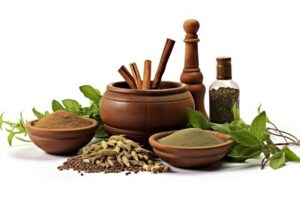
- Impacts of Lifestyle, Stress, and Heat
- Pigmentation is closely related to our lifestyle and is not only about what we put on our skin. According to Ayurvedic philosophy, pigmentation frequently indicates an imbalance and excess of heat in the body and psyche. Excessive heat affects the skin’s natural defences and causes discolouration when paired with long-term stress, poor food, sleep deprivation, and unhealthy behaviours.
- Cortisol, a hormone that upsets hormonal balance and increases inflammation, is released in response to prolonged stress. Particularly in those who are prone to rosacea or acne, this inflammation can exacerbate Pitta and result in an increase in melanin production.
- lifestyle decisions like:
- Overexposure to the sun
- Consuming foods that are too fried or spicy
- Consuming alcoholic beverages
- Smoking
- Unusual sleeping habits
- …are all regarded in Ayurveda as Pitta-aggravating behaviours. These behaviours eventually lead to a poisonous interior environment (Ama accumulation), which worsens skin clarity and liver function.
- In order to address these underlying reasons, Ayurveda suggests Ritucharya (seasonal routines) and Dinacharya (daily routines) that maintain the doshas in balance. Natural methods to improve skin tone and drastically reduce internal inflammation include oil pulling, Abhyanga (self-massage with herbal oils), regular detoxification (Panchakarma), and Pranayama (breathing exercises).
Connection Between Liver Health and Skin Discoloration
- The connection between skin pigmentation and liver function is one of the most important yet often ignored Ayurvedic principles. Both Ayurveda and contemporary science agree that the liver is the body’s detox centre, where it breaks down hormones and purifies the blood.
- Inflammatory skin disorders, dullness, acne, and hyperpigmentation are caused by toxins that build up in the blood when the liver is overworked or slow. This is known in Ayurveda as the buildup of “Ama” (toxic metabolic waste), which travels via the blood (Rakta Dhatu) and deposits in the skin, resulting in pigmentation.
- Neem, karela (bitter gourd), turmeric, aloe vera, and amla are among the bitter foods and herbs that Ayurveda suggests to cleanse the liver and purify the blood.
3. Scientific Perspective: What Causes Skin Pigmentation?
- The function of melanocytes and melanin
- Melanin, the natural pigment that gives our skin, hair, and eyes their colour, is the main factor influencing skin pigmentation. Your skin tone will be darker the more melanin your body generates. Melanocytes, which are specialised cells found in the basal layer of the epidermis (the outermost layer of the skin), are responsible for the synthesis of melanin.
- A complex biochemical process called melanogenesis, which is triggered by a variety of internal and external conditions, is how these melanocytes manufacture melanin. After that, the pigment is sent to the keratinocytes, which are neighbouring skin cells, where it builds up and gives the skin its distinct tone.
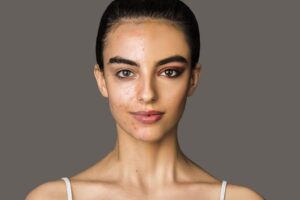
- Two varieties of melanin exist:
- The brown to black pigment known as eumelanin provides UV protection.
- The yellow to reddish pigment known as phenomelanin provides less protection.
- When this equilibrium is upset, pigmentation problems develop. For instance, hyperpigmentation—which manifests as dark areas, blotches, or an uneven tone—occurs when melanocytes become overactive and produce too much melanin. Usually, stressors like sun exposure, injuries, inflammation, or hormonal fluctuations cause this.
UV Exposure, Inflammation, Hormonal Imbalance
- Exposure to UV
UV radiation is the main external factor that causes pigmentation. As a defence mechanism, sunlight exposure, particularly UVA and UVB rays, causes melanocytes to create more melanin. This is the cause of tanning. However, over time, sunspots, freckles, and stubborn pigmentation can result from repeated or prolonged exposure to UV light. - Sun-induced pigmentation frequently manifests as:
- Sunshine lentigines, or sunspots
- Freckles Symptoms
- melasma flare up Even worse
- UV exposure causes oxidative stress, which is covered below and results in pigmentation and skin ageing.
- Post-Inflammatory Hyperpigmentation, or inflammation
- Dark spots may remain on the skin long after it has healed from inflammation brought on by eczema, acne, insect bites, or trauma.
- Post-Inflammatory Hyperpigmentation (PIH) is the term for this. In medium-to-dark skin tones, where extra melanin is produced as a healing reaction, it is most prevalent.
- Pro-inflammatory cytokines, which are triggered by the inflammatory process, cause melanocytes to overproduce melanin at the site of injury.
- An imbalance of hormones
- A significant factor in skin pigmentation is hormones.
- Hormonal changes, particularly in oestrogen and progesterone, are the cause of conditions like melasma, sometimes referred to as the “pregnancy mask.”
- Because of this, melasma frequently develops during pregnancy, while taking birth control pills, or as a result of thyroid disorders.
- How Oxidative Stress Impacts Your Skin Tone
- One of the silent but important causes of pigmentation is oxidative stress. It happens when the body’s levels of antioxidants and free radicals, which are unstable chemicals, are out of balance. Melanocytes are among the cells that can be harmed by free radicals, which are produced by pollution, UV radiation, poor diet, and stress.
- This damage causes blotchy skin, uneven tone, and accelerated ageing by interfering with the normal generation and dispersion of melanin. According to studies, oxidative stress exacerbates problems like age spots and melasma by directly encouraging the overproduction of melanin.
- Antioxidant-rich cosmetics and nutrition are crucial because of this. Components known to fight oxidative stress and lessen pigmentation include vitamin C, niacinamide, green tea extract, liquorice, and resveratrol.
4. Top 5 Ayurvedic Ingredients to Reduce Pigmentation
- The ancient Indian medical tradition known as Ayurveda views pigmentation as a deeper imbalance of internal factors, mainly Pitta dosha and blood pollutants, rather than merely a cosmetic problem.
- Certain herbal and plant-based treatments that naturally lighten pigmentation and enhance general skin health have been suggested by Ayurveda for ages.
- Let’s examine five of the most reliable Ayurvedic ingredients that are supported by both contemporary research and tradition for their ability to reduce pigmentation.
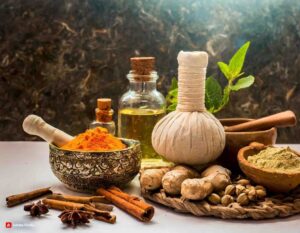
- The Ultimate Blood Purifier: Manjistha (Rubia cordifolia)
- One of the most powerful Rakta Shodhana (blood-purifying) herbs in Ayurveda is manjistha.
- It functions by purifying the lymphatic and circulatory systems, which directly affects the tone and clarity of the skin in accordance with Ayurvedic philosophy.
- Manjistha aids in lowering the body’s heat, toxins (Ama), and inflammation, all of which are factors in melasma and PIH (post-inflammatory hyperpigmentation), two conditions that are difficult to get rid of.
- Additionally, it supports normal liver function, which is essential for melanin management and detoxification. Manjistha can be applied topically in face packs or oils, or it can be taken internally as a tea or tablet.
- It works very well to treat blemishes and acne spots when mixed with neem or turmeric.
- Yashtimadhu (liquorice root): A Natural Skin Brightener
- A mild yet effective Ayurvedic herb, liquorice root helps lessen sun-induced pigmentation, melasma, and dark patches.
- Tyrosinase, an enzyme that promotes the synthesis of melanin, is inhibited by the primary active ingredient, glabridin.
- As a result, liquorice is a natural skin-brightening agent that doesn’t have the harshness of artificial bleaches.
- Additionally, liquorice has antioxidant and anti-inflammatory qualities that soothe sensitive skin and stop pigmentation brought on by acne or sun damage.
- It is frequently used in skincare products including serums, face gels, and under-eye creams to improve radiance, even out skin tone, and erase discolouration, particularly in sensitive skin types.
- Turmeric (Haldi): A potent antioxidant and anti-inflammatory
- For generations, turmeric has been the go-to remedy for skin that is radiant and clean.
- Curcumin, its major ingredient, has strong anti-inflammatory and antioxidant qualities, which makes it perfect for minimising inflammation-induced pigmentation (such as eczema and acne scarring).
- Additionally, turmeric enhances circulation and controls the synthesis of melanin, promoting a better complexion from the inside out. When applied topically, it combats oxidative stress, which speeds up skin ageing and dullness, lightens dark spots, and lessens redness.
- Turmeric can be combined with raw honey, aloe vera, or yoghurt and applied as a face mask once a week for optimal benefits.
- Just be aware that lighter skin tones may experience transient yellow discolouration.
- Aloe Vera: Promotes Skin Regeneration and Soothes
- Aloe vera, also called Kumari in Ayurveda, is a cooling and rejuvenating plant that directly treats Pitta imbalance, which is one of the underlying reasons of pigmentation.
- Sunspots, scars, and post-acne markings can be lessened by hydrating the skin, promoting the formation of collagen, and speeding up cell renewal.
- Compounds including aloin, which has been demonstrated to reduce melanin production and enhance skin clarity, are also found in aloe vera.
- Even sensitive or irritated skin can benefit from this substance, which is among the most skin-friendly.
- To lessen pigmentation and soothe redness and inflammation, use pure aloe vera gel straight from the leaf or as relaxing gels and lotions.
- Cooling and Healing Properties of Sandalwood (Chandan)
- A popular Ayurvedic component, sandalwood is prized for its cooling, anti-inflammatory, and complexion-boosting properties.
- It is perfect for sunburn, melasma, and heat-induced pigmentation since it soothes agitated Pitta and reduces skin irritation.
- The natural oils and chemicals found in sandalwood lighten dark spots, give off a natural shine, and lessen tanning.
- Additionally, it contains antibacterial qualities that help stop pigmentation caused by acne.
- Sandalwood powder can be used with milk, aloe vera, or rose water to create a face pack that brightens and cleanses the skin.
5. Natural Home Remedies That Work for Pigmentation Natural Home Remedies That Work for Pigmentation
- Many individuals are turning to natural home cures, which offer safe, cost-efficient, and tried-and-true alternatives—without harsh chemicals or side effects—even when professional therapies can be successful.
- Reduce Pigmentation Naturally When used correctly and consistently, a variety of readily available kitchen-friendly ingredients found in Ayurveda and traditional Indian skincare knowledge can help remove pigmentation.
- Let’s look at easy daily routines, potent homemade turmeric-licorice gel, and efficient home cures that promote naturally radiant, balanced skin.
- Recipes for Homemade Face Masks Using Common Kitchen Items
- Gramme flour (Haldi + Dahi + Besan) + turmeric + curd
This traditional Ayurvedic Ubtan formula is well-known for removing tans and lightening complexion. - One teaspoon powdered turmeric 1 tablespoon yoghurt (curd) One tablespoon of besan gramme flour A few drops of lemon juice are optional (for oily skin only).
- How it operates: Turmeric lowers inflammation and the synthesis of melanin. Curd moisturises and exfoliates.
- Besan brightens and cleanses gently. After 15 to 20 minutes of application, rinse with lukewarm water. For a noticeable glow and less pigmentation, use twice a week.
- Gramme flour (Haldi + Dahi + Besan) + turmeric + curd
- Honey + Potato Juice
- Catecholase enzymes found in potatoes aid in the fading of pigmentation and dark patches.
- To obtain the juice, grate a raw potato and squeeze it.
- Put one teaspoon of raw honey in. Use a cotton ball to apply, then wait fifteen minutes. Perfect for sunspots, acne scars, and under-eye discolouration.
- Aloe Vera + Rice Flour + Tomato Pulp
Uneven tone and tan can be eliminated with this face pack. One tablespoon of tomato pulp Fresh aloe vera gel, 1 tablespoon One teaspoon of rice flour Apply a light circular massage to the skin and let it sit for 15 to 20 minutes. Lycopene, which is found in tomatoes, acts as a natural sunscreen and helps lighten pigmentation.
- How to Prepare a Homemade Turmeric-Licorice Gel
- Turmeric and liquorice root, two potent pigmentation-fighting ingredients, are combined in this simple herbal gel.
- Components:
- One tablespoon of yashtimadhu (liquorice root powder)
- Half a teaspoon of organic or wild turmeric (kasturi haldi)
- Pure aloe vera gel, two tablespoons
- One teaspoon of rose water
- Two to three drops of vitamin E oil are optional.
- Approach:
- In a bowl, combine the turmeric and liquorice powders.
- To make a smooth, creamy paste, mix in rose water and aloe vera gel.
- Blend till there are no lumps.
- Keep in the fridge for up to seven days in an airtight container.
- Application: Before going to bed each night, dab a small amount of this gel onto regions that are pigmented.
- In the morning, wash it off. This gel reduces melanin formation, soothes irritation, and brightens the skin when used regularly.
Daily Routines That Reduce Pigmentation Over Time
- According to Ayurveda, daily routines (Dinacharya) have an impact on the long-term health of the skin and can stop pigmentation from returning.
- Morning Routine: To cleanse, start your day with warm water and a pinch of triphala powder or turmeric.
- Even indoors, use sunscreen every day to prevent UV-induced pigmentation.
- To get rid of extra oil and pollutants, wash your face in the morning with raw milk or aloe vera.
- Evening Routine: Make use of natural cleansers such as rose water and gramme flour.
- Use masks that target pigmentation two to three times per week.
- Finish with a dab of herbal gel (such as aloe vera-manijshta or turmeric-licorice).
- Weekly Routines: Use a DIY scrub prepared with rice flour and honey to exfoliate.
- Once a week, steam your face with tulsi or neem leaves to cleanse your pores.
6. Lifestyle Tips from Ayurveda to Fade Pigmentation Naturally
- There is a limit to how much pigmentation reduction external treatments can achieve.
- According to Ayurveda, having bright, radiant skin starts on the inside and is greatly impacted by our daily routines, including how we sleep, what we eat, and how we handle stress.
- These internal variables have an impact on the dosha balance, especially Pitta, which can become inflamed and result in pigmentation, dark patches, acne scars, and dullness.
- We’ll look at Ayurvedic lifestyle suggestions in this section that promote skin healing and gradually lessen pigmentation.
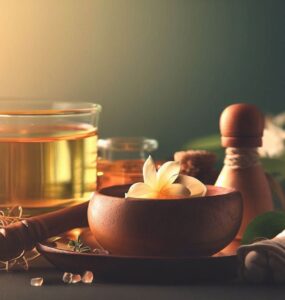
- Dietary Guidelines for Skin Clearness
- Skin is a reflection of Rakta Dhatu (blood tissue) and Rasa (nutritional fluid), according to Ayurveda. The liver, the organ in charge of detoxification and pigment management, is supported by a nutritious, clean diet that maintains these two in balance.
- Here are some Ayurvedic dietary suggestions to enhance the clarity of your skin:
- Favourite foods that cause pitta: cool fruits, such as watermelon, pomegranates, pears, apples, grapes, and sweet berries
- Vegetables: zucchini, ash gourd, pumpkin, cucumber, bottle gourd (lauki) and leafy greens
- Herbs: cardamom, fennel, coriander, and mint
- Grains: quinoa, oats, barley, and rice
- Good fats: moderate amounts of coconut oil, flaxseed oil, and A2 cow ghee
- These meals aid in cooling the circulation, lowering internal heat, and reducing inflammation, all of which are factors in pigmentation.
- Additions That Are Detox Friendly:
- Indian gooseberry, or amla: High in vitamin C, it promotes skin tone and collagen.
- Triphala: A mixture of three fruits that purifies the blood and cleanses the gut.
- Manjistha: Reduces skin imperfections by aiding in liver and lymph detoxification.
- Pro Tip: To eliminate toxins, start your day with warm water flavoured with fresh lemon juice or a pinch of turmeric.
- Avoiding Habits and Foods That aggravate Pitta
- Heat, inflammation, and excessive melanin production are all symptoms of an unbalanced Pitta dosha. In order to balance Pitta and lessen pigmentation, one should refrain from:
- Foods that aggravate pita include fried, spicy, and greasy dishes.
- Overly salty and sour foods (tamarind, pickles)
- Fermented meals (excessive amounts of curd and vinegar)
- Heavy dairy and red meat
- Alcohol and coffee
- Behaviours That aggravate Pitta: Excessive sun exposure
- Eating too much or skipping meals
- Late-night work
- Overuse of screens or vigorous exercise during the hottest parts of the day
- suppressing instincts (such as hunger or sleep)
- To preserve equilibrium and shield the skin from seasonal aggravation of Pitta, particularly during hot months, Ayurveda recommends adhering to a regular daily routine (Dinacharya) and seasonal regimen (Ritucharya).
- Sleep, Stress, and Hydration Practices
- Sleep: Poor sleep degrades pigmentation by altering hormone levels, raising the stress hormone cortisol, and delaying skin restoration. Ayurveda suggests:
- Going to bed before ten o’clock
- Screen time should be avoided at least an hour before bed.
- To calm Pitta, keep your bedroom dark and chilly.
- Overnight skin regeneration and healing are made possible by a regular sleep pattern.
- Stress Management: Pigmentation is secretly triggered by stress. It causes hormonal imbalance, upsets digestion, and raises body temperature. Among the Ayurvedic methods for lowering stress are:
- Pranayama (cooling breathing techniques such as Anulom-Vilom or Sheetali)
- Chanting and meditation (grounding with Om or Beeja mantras)
- Self-massage with cooling oils, such as coconut or Brahmi, is known as abhyanga.
- These techniques promote adrenal health, ease mental tension, and lessen skin inflammation.
- Hydration: Skin that is well-hydrated is less likely to become inflamed and discoloured. According to Ayurveda,
- consuming lukewarm water all day long
- Herbal infusions such as tea made with fennel, coriander, and cumin
- Steer clear of fizzy beverages and chilled water as they interfere with Agni (digestive fire).
- Maintaining proper hydration helps keep the skin supple and radiant while also eliminating pollutants and controlling body temperature.
7. What Science Says About These Natural Treatments
- Ayurvedic and natural treatments for pigmentation are becoming more and more popular worldwide, not just because they are holistic and mild, but also because contemporary research is showing that they work.
- Even though traditional medicine has employed these treatments for millennia, many of their skin-healing qualities are now supported by clinical research.
- The science of liquorice, aloe vera, and turmeric extracts is examined in this section along with how well they work in comparison to more traditional chemical treatments for hyperpigmentation.
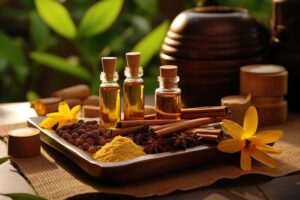
- (Curcuma longa) Turmeric
- Curcumin, the main ingredient in turmeric, has been the subject of much research due to its potent anti-inflammatory, antioxidant, and melanin-inhibiting qualities.
- The capacity of curcumin to inhibit tyrosinase, the enzyme in charge of melanin formation, was emphasised in a 2018 review that was published in the Journal of Clinical and Aesthetic Dermatology.
- Over the course of four to eight weeks, topical formulations containing turmeric extract significantly reduced melasma and dark spots, according to another study published in Phytotherapy Research.
- Additionally, curcumin fights oxidative stress, which is linked to pigmentation and cellular ageing.
- But there have been worries about turmeric’s limited absorption, or low bioavailability. In order to increase skin penetration, researchers have developed nano-curcumin or combined it with lipids or oils (such as coconut or sesame).
- Aloe Vera (Miller’s Aloe barbadensis)
- Another age-old treatment that is now well known in dermatology for its calming, moisturising, and restorative properties is aloe vera.
- Studies have demonstrated that the aloin chemical, which is present in the inner gel of aloe vera plants, inhibits the development of melanin.
- Aloin has depigmenting qualities and can be used to treat hyperpigmented lesions, according to a 2002 study published in Clinical and Experimental Dermatology.
- Aloe vera is especially helpful for post-inflammatory hyperpigmentation brought on by acne or small wounds because it also aids in skin regeneration and restoration. It is perfect for sensitive skin types because it is safe to use every day and rarely irritates the skin.
- Research on the Benefits of Liquorice Extract for Hyperpigmentation
- Glabridin, a flavonoid found in liquorice root (Glycyrrhiza glabra), has been shown to have potent tyrosinase-inhibiting activity, which helps to stop the overproduction of melanin.
- According to a study in the Journal of Dermatological Science, glabridin lightens the skin and reduces inflammation without causing cytotoxicity.
- In contrast to chemical alternatives, liquorice extract creams dramatically reduced melasma and UV-induced pigmentation over the course of four weeks, according to another scientific investigation.
- Because it reduces inflammation and redness in addition to targeting pigmentation, liquorice is particularly helpful for those with sensitive skin. It can also be used on skin that is prone to acne or rosacea.
8. Mistakes to Avoid During Natural Treatment for Pigmentation
- Only when applied correctly, consistently, and with appropriate skin care awareness can natural treatments for pigmentation prove to be quite beneficial. Many people use DIY and Ayurvedic remedies in the hopes of seeing results right away, but they often backfire because they don’t understand how these substances work or apply them incorrectly. Even while natural remedies are kinder than artificial ones, they still need to be used carefully and with discipline to have long-lasting effects.
- Let’s examine the most frequent errors people make when getting natural pigmentation treatments and how to steer clear of them for safer, better outcomes.
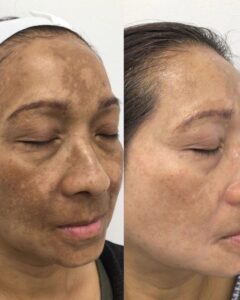
- Excessive sun exposure or exfoliation
- Excessive skin exfoliation is one of the most common mistakes made when taking care of natural pigmentation.
- Too many DIY scrubs and masks, such those prepared with besan, lemon, or rice flour, are used too frequently or scrubbed too vigorously.
- Reasons for harm: Excessive exfoliation damages the skin’s protective layer, which causes dryness, irritation, and increased pigmentation, particularly in darker skin tones.
- Additionally, it can cause post-inflammatory hyperpigmentation (PIH), especially in skin that is melanin-rich or prone to acne.
- Likewise, weeks of improvement might be undone by too much sun exposure. Exposure to sunlight just after use might exacerbate photosensitivity, even for natural remedies like citrus-based masks or turmeric.
- Unreliable Use
- Expecting outcomes without maintaining consistency is another typical mistake. Natural remedies for pigmentation progressively improve cell regeneration, reduce inflammation, and restore internal equilibrium.
- The error: Applying a mask or gel “occasionally” and giving up after a few attempts. utilising several medicines at random or skipping treatments during hectic times.
- Why it matters: For noticeable results, natural substances must be used consistently over a period of 4 to 8 weeks or more, because pigmentation frequently develops deep into the skin layers. Best Practices:
- Pick one or two skin-friendly medicines and apply them regularly.
- Follow a routine (e.g., twice-weekly face masks plus turmeric-licorice gel every night).
- Instead than expecting results right away,
- use images to document your development.
9. When to See a Dermatologist
- Although they provide strong assistance for skin pigmentation, natural therapies and Ayurvedic treatments can not always be sufficient on their own.
- Even though home care helps a lot of people, there are some circumstances in which expert advice is necessary. Deeper pigmentation, permanent scarring, or the failure to notice a significant underlying problem can result from ignoring worsening symptoms or postponing a medical consultation.
- You may take prompt action, securely combine clinical and natural treatment, and safeguard the general health of your skin by knowing when to see a dermatologist.

- Should Pigmentation Aggravate or Proliferate
- When pigmentation persists in darkening, extends to other areas of the face or body, or intensifies in spite of routine natural therapy, these are some of the most obvious indicators that it’s time to get expert assistance. Indications that call for medical intervention:
Abruptly, more black areas develop. - The pigmentation gets darker, itchier, or more prominent. After two to three months, DIY remedies don’t show any difference. An uneven tone begins to undermine one’s self-esteem or emotional health. These alterations could be signs of post-inflammatory pigmentation, lichen planus pigmentosus, or melasma, illnesses that frequently improve with topical treatments such retinoids, azelaic acid, or dermatological peels.
- What a dermatologist can do: Determine the kind and extent of pigmentation with accuracy Suggest safe, customised procedures (such as chemical or laser peels).
- When pigmentation persists in darkening, extends to other areas of the face or body, or intensifies in spite of routine natural therapy, these are some of the most obvious indicators that it’s time to get expert assistance. Indications that call for medical intervention:
- Indications of Fundamental Health Problems
- Pigmentation may occasionally indicate systemic disease or internal abnormalities. Modern medicine examines hormonal and autoimmune diseases, while Ayurveda attributes pigmentation to a weak liver or an inflamed Pitta dosha.
- Pigmentation may be a warning sign in the following situations:
- Hormonal conditions such as adrenal fatigue, thyroid imbalance, or PCOS Liver problems that impact bile production and detoxification inadequacies in nutrition, particularly in iron or B12 Autoimmune diseases like lupus or Addison’s disease Drug-induced pigmentation brought on by chemotherapy or antimalarial drugs It’s critical to see a healthcare professional for a complete physical if you suffer from exhaustion, weight gain or loss, irregular periods, digestive issues, or skin changes.
10 Final Thoughts: Holistic Healing is Key
- Many people look for quick cures, such as harsh creams, speedy treatments, or fashionable do-it-yourself tricks, in an attempt to get clear, even-toned skin.
- However, as this blog series has demonstrated, a more thorough and well-rounded strategy is needed to get real and long-lasting pigmentation treatment. Internal health, emotional stability, and lifestyle decisions are all reflected in one’s skin.
- Therefore, the secret to change is total healing rather than merely surface-level mending.
- The best sustainable route to healthy skin, regardless of whether you’re dealing with melasma, sunspots, or post-acne markings, is a blend of Ayurvedic knowledge, contemporary science, and patient self-care.
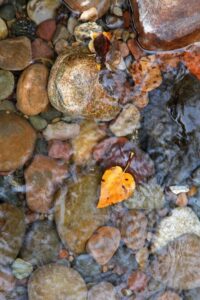
- Be Consistent and Patient
- The fact that skin healing takes time is one of the most significant facts in both dermatology and Ayurveda. Expecting an instant reversal is impractical and can be distressing because pigmentation frequently takes weeks, months, or even years to emerge. Aloe vera, liquorice, manjistha, and turmeric are examples of natural treatments that gradually improve health. They purify the blood, reduce inflammation, balance melanin synthesis, and restore skin function.
- Maintaining consistency is essential. There won’t be any noticeable difference if you use a face mask once a week or avoid wearing sunscreen on a daily basis. What functions is:
- Gentle skincare routines every day
- Using tried-and-true components consistently
- Protection against the sun, both inside and out
- Providing your body with the right nutrition, water, and rest
- Integrate Tradition and Science for Long-Term Skin Health
- Dermatology and Ayurveda don’t have to be chosen. In actuality, integrating the advantages of both methods frequently yields the best outcomes.
- Ayurveda provides lifestyle advice, cleansing, and root-cause correction.
- Science offers precise diagnostics, sophisticated formulations, and focused treatments.
- This combination has great power. For instance, a vitamin C serum or a night cream recommended by a dermatologist can be used in conjunction with an Ayurvedic diet and herbal cleanse. If used carefully, a homemade turmeric-licorice gel can complement niacinamide or hyaluronic acid. To prevent overusing or irritating your skin, it’s important to know which ingredients are acceptable to combine and to use them in different amounts.
- Accept the Balance Journey of Your Skin
- Lastly, pigmentation is a normal reaction of your skin to defend, repair, and preserve itself; it is not merely a cosmetic problem. Consider it a signal rather than a defect. A reminder to slow down, show greater concern, and take care of oneself. You’ll start to see improvements in your self-perception as well as on the outside when you stop battling your skin and start supporting it.
- Perfection is not the goal of glowing skin. It all comes down to confidence, clarity, and balance. The idea of “Twacha Rogas” (skin disorders) in Ayurveda serves as a reminder that skin conditions are transitory states rather than enduring characteristics. Additionally, aware living has the power to change them.
FAQS
1. What is skin pigmentation and why does it happen?
Skin pigmentation refers to the coloring of your skin caused by melanin. Factors like sun exposure, hormonal changes, inflammation, or injuries can lead to uneven pigmentation or dark spots.
2. Can pigmentation be permanently removed naturally?
While complete removal is not always guaranteed, consistent use of natural ingredients like turmeric, licorice, and aloe vera can significantly reduce pigmentation over time. Ayurveda focuses on treating the root cause to prevent recurrence.
3. How does Ayurveda treat skin pigmentation?
Ayurveda identifies pigmentation as a result of Pitta dosha imbalance, often linked to internal heat, poor liver health, and diet. It uses herbs like manjistha, sandalwood, and blood-purifying remedies to restore balance.
4. What are the most effective Ayurvedic ingredients for pigmentation?
Top Ayurvedic ingredients include:
Manjistha – blood purifier
Licorice root – melanin inhibitor
Turmeric – anti-inflammatory
Aloe Vera – skin soother
Sandalwood – cooling and healing
5. Are home remedies like turmeric or sandalwood safe for daily use?
Yes, when used correctly and in moderation. Mix with soothing bases like aloe vera gel or milk. Avoid applying raw turmeric alone daily, as it may irritate sensitive skin.
6. Can diet affect pigmentation?
Absolutely. According to Ayurveda, spicy, oily, and fried foods aggravate Pitta and may worsen pigmentation. Include cooling foods like cucumbers, leafy greens, coconut water, and pomegranate.
7. How long does it take to see visible results with Ayurvedic treatments?
You may begin seeing changes in 4 to 6 weeks, but deeper healing can take 2–3 months. Natural treatments require consistency and patience, but the results are long-lasting and safer than chemical treatments.
8. Can I combine natural remedies with dermatologist treatments?
Yes, but with caution. Use Ayurvedic ingredients on alternate days or under expert guidance to avoid interactions with actives like retinol, AHAs, or hydroquinone.
9. What mistakes should I avoid during natural treatment?
Skipping sunscreen
Overusing lemon or raw turmeric
Inconsistent application
Mixing too many ingredients without testing for reactions
10. When should I consult a dermatologist?
If your pigmentation worsens, spreads rapidly, or shows unusual colors (blue/grey), it may indicate deeper issues. Combine clinical care with natural support for best results.
